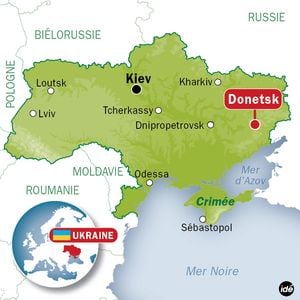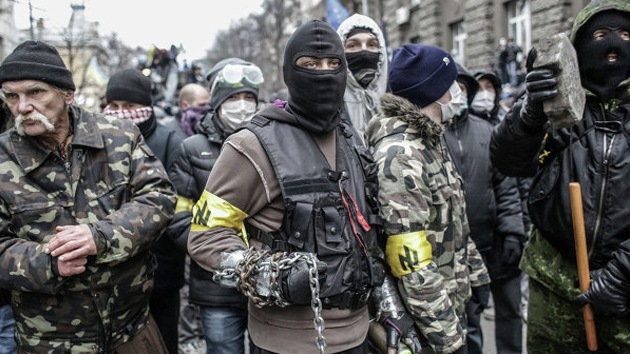War in Donbass on “Russia’s Doorstep”: 3,600 Civilians Killed by Ukrainian Forces and Neo-Nazi Militia since Minsk II Agreement

According to figures obtained from the Donetsk People’s Republic (DPR) authorities, since the February 2015 Minsk II agreement over 3,600 civilians have died in the republic due to shelling, sniper and other attacks by the Armed Forces of Ukraine.
The DPR, along with the Luhansk People’s Republic (LPR), broke away from Ukraine in May 2014 following ‘status referendums’, and on 24 May the two separatist republics signed an agreement creating a confederation, Novorossiya, but the region is more widely known as the Donbass.
After the February 2014 coup in Kiev, an ‘Anti-Maidan’ movement rapidly grew in the largely Russian-speaking Donbass, Odessa and Crimea regions, which sought to prevent the far-right groups which hijacked in the ‘Euromaidan’ protests entering their towns and cities.
Their fears were confirmed by the Odessa Trade Union House fire on 2 May 2014, in which at least 50 Anti-Maidan supporters died when the building was surrounded by a far-right mob and petrol-bombed.
There are reports of civilian casualties caused by Ukrainian strikes on the rebel republics on an almost daily basis. On 28 August, according to residents of the Petrovsky district of Donetsk city, a Ukrainian sniper shot two women dead.
It was hoped that Minsk II, which followed the September 2014 Minsk Protocol and was signed by Vladimir Putin, Angela Merkel, Francois Holland and Ukrainian president Petro Poroshenko, would bring the war in eastern Ukraine to an end, paving the way for elections and separate status for the two Donbass ‘people’s republics’.
However low-level clashes have continued unabated for the past 18 months, with increasing warnings of escalation and a build-up of forces and equipment by the Ukrainian side in recent months. Tensions were heightened three weeks ago by allegations of armed incursions by Ukrainian forces into Crimea.
According to data obtained recently from the DPR authorities, 3,609 civilians died in strikes by Ukrainian forces between 13 February 2015 and 26 August 2016, of which 3,133 were men, 476 women, 65 children and 352 “unknown”.
In addition, figures from the DPR Ministry of Utilities and Housing Construction state that up 20 July 2016 4,359 ‘multi-family housing’ were damaged, of which 54 are irreparable, and 6,307 private houses damaged, of which 1,853 are irreparable.
As the neighbouring Luhansk People’s Republic (LPR) has also experienced similar military strikes and civilian casualties, a very rough estimate would suggest that at least 6,000 civilians have died in strikes by Ukrainian forces on the Donbass republics since Minsk II.
Obtaining accurate figures for casualties in the war in eastern Ukraine is extremely difficult due to the unstable and insecure situation on the ground, and the fact that the conflict is highly politicised and controversial not only locally, but across Europe and globally.
On 3 August the UN assistant secretary-general for political affairs Tayé-Brook Zerihoun reported to the UN Security Council that the total number of conflict-related casualties since the Ukrainian government launched its ‘Anti-Terrorist Operation’ in April 2014 was 30,729, including 9,333 killed and 21,396 injured.
Neo-Nazi militia
But the report provides no breakdown of where the casualties have occurred other than “in the conflict area”, and there is no indication of which side was responsible.
According to the latest figures from the UN Human Rights Office and the UN High Commissioner for Human Rights, from February 2015 to June 2016 261 civilians were killed in the conflict on both sides – far fewer than the DPR’s figures would suggest.
However, the UNHRO stresses that its figures are a “conservative estimate of the OHCHR based on available data” which are “incomplete due to gaps in coverage of certain geographic areas and time periods, and due to overall under-reporting”.
In February 2015, press reports quoted claims from the German BND intelligence service that 50,000 civilians and servicemen people had died in the Ukraine conflict, almost 10 times than figures given by Ukrainian president Petro Poroshkenko only days before, which said 1,200 Ukrainian soldiers and 5,400 civilians had died.
In fact the Ukraine government does not appear to have any accurate figures for civilian casualties in the conflict. A report in May quoting Mykhailo Koval, First Deputy Secretary of the National Security and Defence Council, says “Russia-backed militants have killed 10,000 Ukrainians and injured more than 20,000 over the past two years” – a strangely precise number, but with no breakdown of civilian and military casualties, or locations.
The only other body providing detailed information on casualties in the conflict is the OSCE Special Monitoring Mission (SSM) to Ukraine, which has over 570 unarmed civilian monitors in the conflict region. But apart from daily updates, the SMM has provided no total figures for casualties in the conflict, although it has issued reports on the displacement of civilians, access to water, and “Gender Dimensions of SMM’s Monitoring”.
Relations between the DPR and LPR governments and the OSCE mission have been deteriorating for months. The people’s republics claim its reporting is biased towards the Ukrainian side, while the OSCE alleges its monitors are being harassed on the territories of the republics.
On 29 August the DPR’s Defence Ministry claimed OSCE observers had refused to register damage caused by Ukrainian shelling of Yasinivataya, just north of Donetsk city, “explaining this by the absence of security in this area”.
Last April, the Donbass International News Agency reported that the OSCE mission failed to report heavy shelling of Zaitsevo, a village close to the frontline by Ukrainian forces. At the time Zaitsevo was a flashpoint stoking fears of a return to all-out war, with over a thousand residents denied electricity, gas and humanitarian aid for several months.
It was also claimed in April that the OSCE failed report the shelling of a hospital in Yelenovka, despite reporting another shelling only 880 meters away. According to reports from the DPR side, 6 civilians were killed and 10 wounded in the two strikes.
The OSCE Special Monitoring Mission to Ukraine’s mandate states that its mission is “to reduce tensions and to help foster peace, stability and security” by engaging “with authorities at all levels, as well as civil society, ethnic and religious groups and local communities to facilitate dialogue on the ground”.
Last May, the leaders of the DPR reacted strongly to claims by Petro Poroshenko’s press office that the other leaders of the ‘Normandy four’ contact group (Russia, France, Germany and Ukraine) had approved the deployment of an armed OSCE police force to the region, which according to Poroshenko would be “well-armed with heavy weapons”.
The most senior members of the DPR government, Denis Pushilin and Alexander Zakharchenko said such a force would be “foreign intervention”, and Zakharchenko called on Kiev to make a real effort for a peaceful settlement of the conflict, “rather than trying to arm the OSCE to seize the Donbass”.
It is important to bear in mind that the ‘Armed Forces of Ukraine’ include 84 far right and neo-Nazi militias who were incorporated into the AFU last year. These forces are extremely undisciplined, and to this day they continue to run amok across Ukraine, mounting racist, anti-semitic, anti-communist and homophobic attacks, murdering journalists, threatening and intimidating judges, and frequently kidnapping defendants when they are released by the courts.
These militias have played a major role in the ongoing clashes on the contact line with the Donbass, as well as deliberately targeting civilians on the DPR and LPR side in various ways.
The latest ceasefire announced on 1 September announced by the ‘Trilateral Contact Group’ (Ukraine, Russia, and the OSCE) showed promise of holding for several days, building hopes of a return to talks on the implementing of Minsk agreements, but already the Ukrainian side is alleging violations by the DPR and LPR.
Despite the problems with obtaining a clear picture of casualties in the eastern Ukraine conflict, what is clear is that up to now the fighting has continued with civilian and military casualties on both sides, and this has blocked any prospect of a resolution allowing separate status for the Donbass republics.
Given the huge variations in figures given by the various parties, the latest very detailed data from the Donetsk People’s Republic authorities should be given serious consideration by observers.


